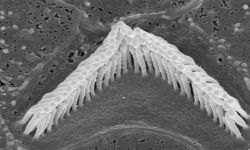
Towards a treatment for type 1 Usher Syndrome
- Details
- Published on 21 February 2013
Research

A team of American researchers, led by Michelle Hastings (Rosalind Franklin University), has recently developed a technique to rescue hearing in a mouse model of type 1 Usher Syndrome. In 6 to 8% of cases, type 1 is caused by mutation of the Ush1c gene.
They achieved this advance using antisense therapy. By injecting the mice with specific antisens oligonucleotide (ASO) targeting the desired messenger RNA, scientists were able to reactivate the process which leads to the synthesis of harmonin, an architectural protein which plays a key role in the morphogenesis of ciliated cells.
The treated mice recovered not only their hearing, but also their vestibular function, as shown by auditory brainstem response (ABR) of treated mice in comparison with normal mice. These observations are additionally confirmed by the presence of normal quantities of harmonin and functioning ciliated cells in the cochlea of treated mice.
The scientists noted however, that for the treatment to be effective, it must be applied during ciliated cell development: if the treatment takes place at 10 days old, only vestibular function will be recovered. By carrying out treatment 5 to 7 days earlier (P3-P5), it is possible to recover normal hearing, with auditory brainstem response equivalent to that of healthy mice. This is consistent with the fact that, although the Ush1c gene is expressed from the 15th day of the embryonic stage, its strongest expression takes place between the 4th and 15th days of life.
However, treatment efficacy is not sustained. As a result, 6 months later, the hearing of the mice begins to deteriorate. Researchers additionally noted that this technique does not allow for as successful a recovery of high frequency hearing (32 kHz) as it does for lower frequency hearing. It is possible that this is due to tonotopic gene expression. As a result, the scientists suggest that at 5 days old, the gene is not expressed yet in the base of the cochlea, where high frequencies are detected.
But Usher syndrome does not only affect hearing function. It also damages eyesight. No improvement was noted for this sense and the retinal cells of the Usher mice eventually deteriorate by one year of age.
Source: Lentz J.J. et al. Rescue of hearing and vestibular function by antisense oligonucleotides in a mouse model of human deafness. Nature Medicine 2013
Source: Towards a treatment for type 1 Usher Syndrome
Link:Towards a treatment for type 1 Usher Syndrome
REF: Hearing Aids, Hearing Loss, Digital Hearing AidsThe article comes from the Internet. If there is any infringement, please contact service@jhhearingaids.com to delete it.






